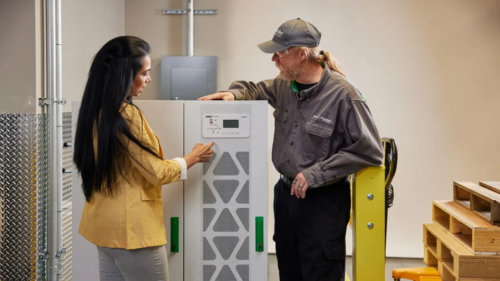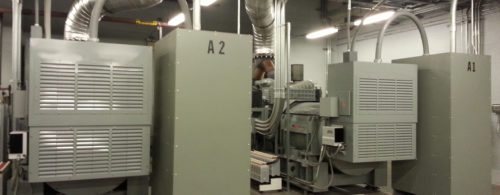Pros and cons of networked genset controls: Web exclusive
Having standby and emergency power systems connected to a networked controls system can provide monitoring and alarm functions should potential problems arise. However, there are differing opinions about connecting any kind of backup system to a network. Here two industry experts discuss the pros and cons of connecting these power systems to a network.
Meet our roundtable participants:
- Carlos Petty, vice president, group manager, Syska Hennessy Group, New York
- Kenneth Lovorn, PE, president, Lovorn Engineering Associates, Pittsburgh
Q: Discuss your firm’s involvement with standby and emergency power systems that are connected to a networked control/automation system.
Petty: It has been our experience that projects based on an intelligent building solutions model require experienced engineering consultants that can bridge the gap between IT and facility-based systems.
Lovorn: We have designed numerous emergency power systems for hospitals, data centers, and other critical loads, but none of them were intended to be connected to a control/automation system.
Q: To what extent are the standby and emergency power systems with which you work associated with a control/automation system network (e.g., remote annunciation, alarms, BAS, genset control, other)?
Petty: Many of our international projects originating in Korea, China, or in the Middle East require the design of an intelligent building management system and a command and control center (CCC). Emergency power systems operating health status and alarms are typically monitored. Remote control of generators is typically not done. The CCC houses a unified monitoring station, which replaces the requirement for an individual dedicated station serving emergency power and building automation while drastically improving functionality and overall performance of each system by integrating them into an enhanced IT infrastructure.
Lovorn: With the exception of remote annunciation provided by the generator manufacturer, we strongly discourage connecting these systems to a BAS.
Q: In your experience, what is the state of the art regarding networked controls for standby or emergency power systems?
Petty: Controls for standby or emergency power systems have evolved due to the rapid growth of technology, coupled with the national initiative to move the U.S. electrical grid to a Smart Grid model. This has propelled manufacturers of standby or emergency power systems to adapt and quickly create opportunities to meet new control and data power optimization applications such as utilities and demand response programs, where power generating equipment is considered part of a total energy management movement in the digital age.
Q: What insights does your firm offer regarding how these networked controls for standby or emergency power systems are best applied?
Petty: When connected to an IT communication network, emergency power systems can capitalize on the advancements of the IT world: high-bandwidth cabling practices, allowing for information data exchange using a common cabling infrastructure based on Ethernet technology.
These systems are best applied for projects where multiple sites exist and real-time asset management is required. Active visibility into real-time equipment health data (oil pressure, battery voltage, fuel level, ac current, ac voltage, low voltage, and low fuel, for example) will help to predict failures and will provide automatic notification when equipment maintenance is required to maintain equipment at its optimal operating level.
Projects such as data centers, manufacturing plants, and health centers are candidates for this application due to the critical nature of maintaining high reliability and uptime.
Lovorn: Generator systems are used as backup power systems for the operation of critical loads in a facility. The more connections there are to external systems, the more opportunities are created to have a single point failure. Without having some method of total electrical isolation of the monitoring system, every additional auxiliary contact, voltage connection, or other monitoring methodology is another opportunity for that system to fail.
Q: What are the advantages of networked control/automation systems for standby or emergency power?
Petty: Traditional emergency power system equipment functions as an independent system. New state-of-the-art emergency power systems are now capable of supporting standard Internet protocol communications. This advancement allows multiple emergency power system sites to be monitored instantaneously and remotely. Essential standby and emergency equipment operating parameters can now be recorded automatically without the need for additional personnel.
When coupled with logic-based analytical software, these new emergency power systems are capable of automatically interpreting collected data, reaching viable solutions, providing instant notification, and automatically implementing the appropriate corrective actions, if required.
Lovorn: The big disadvantage of networked control and automation of an emergency system is the increased risk of a failure that is caused by the monitoring system. While we are certain that these monitoring systems are designed to minimize the chances that they could cause a problem with the emergency generation system, as long as there is an electrical connection between the emergency system and the monitor, there is an opportunity for a system failure.
Q: In your experience, what percentage of the installed standby or emergency genset base employs networked control/automation systems?
Petty: Less than 10%, but growing.
Q: What are the code implications of networking controls and monitoring? There are some code requirements in National Fire Protection Association (NFPA) 110; which affect what you’re doing?
Petty: NFPA 110: Standard for Emergency Power Systems requires the recording of key operating health statuses on a monthly basis. Typically, this is done manually via pen and paper by several facility personnel. The recorded data depend on each of the individual data loggers. We believe that facility personnel are better used for visual inspections of each standby and emergency power system. An important part of regulatory compliance initiatives for emergency power systems is to maintain special accreditation or state licensing for the use of these systems. Automating the recording of this data through a networked monitoring system provides consistency and time-stamped electronic records. The network system should be considered as a secondary source of reporting.
Q: Does this replace the code-required monitoring and alarms, per NFPA 110? What is the power supply for the network system?
Petty: Most standby and emergency power systems have dedicated annunciator panels that are used to display system status conditions configurable to the standards of NFPA 99/110. These panels can be mounted local to the equipment or remotely, usually at a 24-hr manned engineer site location. Information obtained from emergency generators connected to a communication network should be considered in addition to these monitoring panels. Local authorities having jurisdiction are responsible for the final code interpretation. However, the application of networked emergency power systems does help in automating weekly and monthly written compliance reports required by NFPA 99/110.
Q: Is there a code-required wiring method for this system? Share your experience.
Petty: The network communication cabling system should be considered “in addition to” as a reporting system only. Cabling and cable connector standards must conform to ANSI, Electronics Industries Association, Telecommunication Industries Association, and the International Standards Organization.
Q: How many points or which points of the system should be monitored? In addition to the EPSS, would you want to monitor transfer switches and other emergency system components?
Petty: The following points should be monitored for Level 1 EPSS applications based on NFPA 110:
- Engine run
- Common alarm
- System shutdown
- ATS test switch status
- ATS to normal
- ATS to emergency
- Loss of utility
- Not in auto
- Low fuel switch
- Fuel level
- Engine hours
- Oil pressure
- Coolant temperature
- Exhaust temperature
- Battery voltage
- Battery charger dc current
- ac voltage phase A-B
- ac voltage phase B-C
- ac voltage phase C-A
- ac current phase A
- ac current phase B
- ac current phase C
- Frequency
- Real power
- Real energy
- Power factor
- Low fuel threshold
- Low battery voltage threshold
- Time delay to transfer
- Time delay to retransfer
- Time delay to stop (cool-down)
- Load kW percentage (calculated).
Do you have experience and expertise with the topics mentioned in this content? You should consider contributing to our CFE Media editorial team and getting the recognition you and your company deserve. Click here to start this process.




